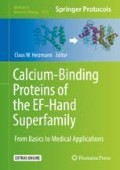Abstract
Oncologic relevant members of S100 proteins are described as promising biomarkers in molecular pathology for risk estimation in oral neoplasia exhibiting different stages of malignancy: gingiva as healthy tissue, irritation fibroma as benign, leukoplakia as precancerous, and oral squamous cell carcinoma as malignant entity. Gene expression levels of S100A4 (metastasin), S100A7 (psoriasin), S100A8 (calgranulin A), and S100A9 (calgranulin B) were analyzed using quantitative RT-PCR. In addition, immunohistochemistry-based microscopy was used to examine cellular localization and distribution of these biomarkers in tissue sections. The results indicate that S100 proteins represent promising biomarkers for early-stage diagnosis in oral lesions. The inclusion of expression profiles and ratios for each entity even improves their diagnostic validity.
Access this chapter
Tax calculation will be finalised at checkout
Purchases are for personal use only
References
Donato R (2001) S100: a multigenic family of calcium-modulated proteins of the EF-hand type with intracellular and extracellular functional roles. Int J Biochem Cell Biol 33:637–668
Donato R, Cannon BR, Sorci G, Riuzzi F, Hsu K, Weber DJ, Geczy CL (2013) Functions of S100 proteins. Curr Mol Med 13:24–57
Heizmann CW, Fritz G, Schäfer BW (2002) S100 proteins: structure, functions and pathology. Front Biosci 7:d1356–d1368
Donato R (2003) Intracellular and extracellular roles of S100 protein. Microsc Res Tech 60:540–551
Chen H, Xu C, Jin Q, Liu Z (2014) S100 protein family in human cancer. Am J Cancer Res 4:89–115
Wenghoefer M, Pantelis A, Najafi T, Deschner J, Allam JP, Novak N, Reich R, Martini M, Bergé S, Fischer HP, Jepsen S, Winter J (2010) Gene expression of oncogenes, antimicrobial peptides, and cytokines in the development of oral leukoplakia. Oral Surg Oral Med Oral Pathol Oral Radiol Endod 110:351–356
Winter J, Pantelis A, Allam JP, Novak N, Reich R, Martini M, Bergé S, Deschner J, Jepsen S, Wenghoefer M (2011) High α-defensin and S100A7 expression and missing DOC-1 down-regulation characterize irritation fibromas of the oral cavity and might counteract malignant transformation. J Craniofac Surg 22:100–104
Winter J, Pantelis A, Reich R, Jepsen S, Allam JP, Novak N, Wenghoefer M (2011) Risk estimation for a malignant transformation of oral lesions by S100A7 and Doc-1 gene expression. Cancer Investig 29:478–484
Reckenbeil J, Kraus D, Probstmeier R, Allam JP, Novak N, Frentzen M, Martini M, Wenghoefer M, Winter J (2016) Cellular distribution and gene expression pattern of metastasin (S100A4), Calgranulin A (S100A8), and Calgranulin B (S100A9) in oral lesions as markers for molecular pathology. Cancer Investig 34:246–254
Harris TM, Du P, Kawachi N, Belbin TJ, Wang Y, Schlecht NF, Ow TJ, Keller CE, Childs GJ, Smith RV, Angeletti RH, Prystowsky MB, Lim J (2015) Proteomic analysis of oral cavity squamous cell carcinoma specimens identifies patient outcome—associated proteins. Arch Pathol Lab Med 139:494–507
Pfaffl MW (2001) A new mathematical model for relative quantification in real-time RT-PCR. Nucleic Acids Res 29:e45
Bustin SA, Benes V, Garson JA, Hellemans J, Huggett J, Kubista M, Mueller R, Nolan T, Pfaffl MW, Shipley GL, Vandesompele J, Wittwer CT (2009) The MIQE guidelines: minimum information for publication of quantitative real-time PCR experiments. Clin Chem 55:611–622
Acknowledgment
R. Probstmeier and D. Kraus contributed equally to this work.
Author information
Authors and Affiliations
Corresponding author
Editor information
Editors and Affiliations
Rights and permissions
Copyright information
© 2019 Springer Science+Business Media, LLC, part of Springer Nature
About this protocol
Cite this protocol
Probstmeier, R., Kraus, D., Wenghoefer, M., Winter, J. (2019). S100 Proteins as Biomarkers in Risk Estimations for Malignant Transformation in Oral Lesions. In: Heizmann, C. (eds) Calcium-Binding Proteins of the EF-Hand Superfamily. Methods in Molecular Biology, vol 1929. Humana Press, New York, NY. https://doi.org/10.1007/978-1-4939-9030-6_48
Download citation
DOI: https://doi.org/10.1007/978-1-4939-9030-6_48
Published:
Publisher Name: Humana Press, New York, NY
Print ISBN: 978-1-4939-9029-0
Online ISBN: 978-1-4939-9030-6
eBook Packages: Springer Protocols

